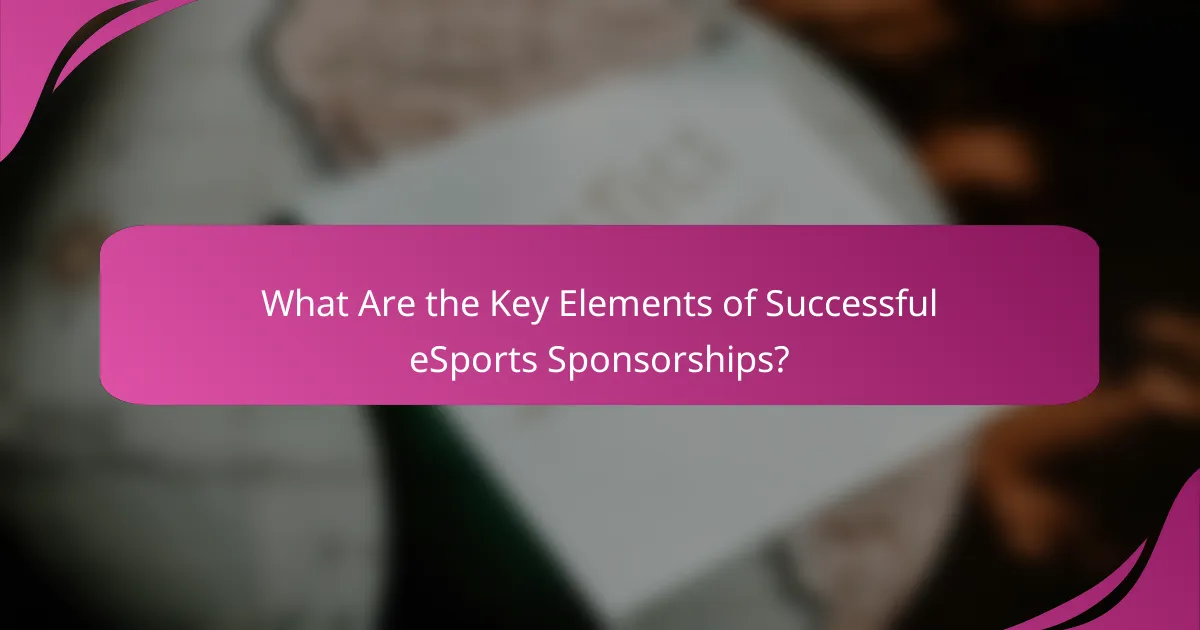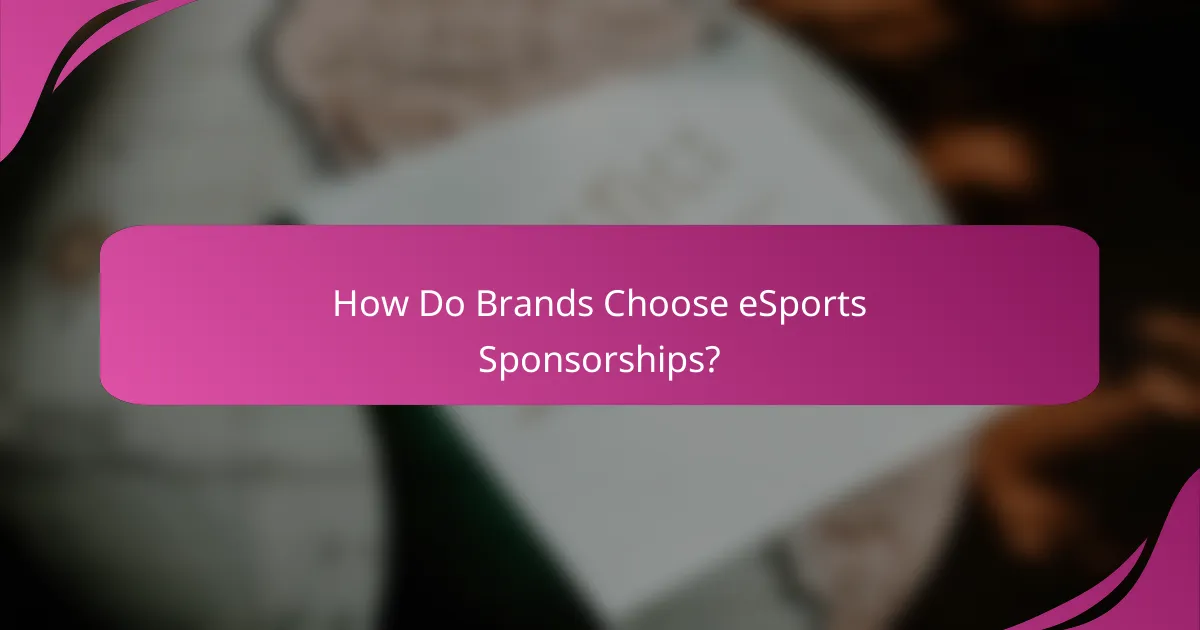Successful eSports sponsorships are built on a foundation of strategic alignment between brands and their target audiences, focusing on critical elements such as audience understanding and effective visibility strategies. By analyzing case studies of notable partnerships, we can uncover insights and lessons that illustrate how brands can enhance their visibility and engagement within the gaming community. These collaborations not only elevate the sponsor’s presence but also foster long-term relationships that benefit both parties.

What Are the Key Elements of Successful eSports Sponsorships?
Successful eSports sponsorships hinge on several critical elements that ensure alignment between brands and their target audiences. Key factors include understanding the audience, implementing effective visibility strategies, measuring engagement, creating compelling content, and fostering long-term partnerships.
Target Audience Alignment
Aligning with the target audience is crucial for eSports sponsorship success. Brands should identify the demographics, interests, and behaviors of gamers and fans to tailor their messaging effectively. For instance, a brand targeting younger audiences may focus on platforms like Twitch or Discord, where engagement is high.
Understanding the audience’s preferences can also guide sponsorship decisions, such as selecting the right teams or events to partner with. Brands should conduct market research to ensure their sponsorship resonates with the intended demographic.
Brand Visibility Strategies
Effective brand visibility strategies are essential for maximizing the impact of eSports sponsorships. This can include logo placements on team jerseys, in-game advertisements, and event signage. Brands should consider various touchpoints to ensure consistent exposure across multiple platforms.
Utilizing social media channels to promote sponsorships can further enhance visibility. Engaging content, such as behind-the-scenes footage or player interviews, can attract attention and foster a connection with the audience.
Engagement Metrics
Measuring engagement metrics is vital for assessing the effectiveness of eSports sponsorships. Key metrics include viewer counts, social media interactions, and brand recall rates. Brands should track these metrics to evaluate the return on investment (ROI) of their sponsorship efforts.
Setting specific goals, such as increasing brand mentions by a certain percentage or boosting website traffic, can help in measuring success. Regular analysis of these metrics allows for adjustments to strategies as needed.
Content Creation
Creating engaging content is a cornerstone of successful eSports sponsorships. Brands should develop content that resonates with the gaming community, such as tutorials, gameplay highlights, or community challenges. This not only promotes the brand but also enhances the overall gaming experience.
Collaborating with popular streamers or content creators can amplify reach and credibility. Brands should ensure that the content aligns with their values and appeals to the target audience to foster genuine connections.
Partnership Longevity
Building long-term partnerships is essential for sustained success in eSports sponsorships. Brands should focus on developing relationships with teams, players, and event organizers that extend beyond single events. This fosters loyalty and deeper connections with the audience.
Regular communication and collaboration can help maintain these partnerships. Brands should also be open to evolving their strategies based on feedback and changing trends within the eSports landscape to ensure continued relevance.

How Do Brands Choose eSports Sponsorships?
Brands select eSports sponsorships based on strategic alignment with their marketing goals, target audience, and the potential for engagement. They consider factors such as the popularity of the game, the reputation of the team or player, and the overall reach of the event.
Market Research Techniques
Effective market research techniques include surveys, focus groups, and social media analysis to gauge audience interest and brand perception. Brands often analyze existing sponsorships to identify successful strategies and common pitfalls. Tools like Google Trends and social listening platforms can provide insights into current eSports trends and fan engagement levels.
For instance, brands might survey gamers to understand their preferences regarding sponsorships, which can inform decisions on which teams or events to support. This research helps tailor sponsorships to resonate with the target demographic.
Competitive Analysis
Conducting a competitive analysis involves evaluating what other brands are doing in the eSports space. Brands should examine competitors’ sponsorships, messaging, and engagement strategies to identify gaps and opportunities. This analysis can reveal which teams or events are attracting attention and how brands are positioning themselves within the market.
For example, if a competitor sponsors a popular team, a brand might consider sponsoring a rising team to capture a different segment of the audience. Understanding competitors’ successes and failures can guide brands in crafting their unique approach.
Audience Demographics
Understanding audience demographics is crucial for brands when choosing eSports sponsorships. Key demographic factors include age, gender, geographic location, and gaming preferences. Brands should aim to align their sponsorships with demographics that match their target market to maximize impact.
For instance, if a brand’s primary audience is young adults aged 18-24, sponsoring a game popular among that age group can enhance brand visibility. Additionally, analyzing regional preferences can help brands decide whether to invest in local tournaments or global events, ensuring their sponsorship resonates with the intended audience.

What Are Notable eSports Sponsorship Case Studies?
Notable eSports sponsorship case studies highlight successful partnerships that enhance brand visibility and engagement within the gaming community. These collaborations often involve strategic marketing initiatives that resonate with the target audience, leading to mutual benefits for both sponsors and teams.
Red Bull and Team SoloMid
Red Bull’s partnership with Team SoloMid (TSM) exemplifies a successful eSports sponsorship. By aligning with TSM, Red Bull not only gained access to a dedicated fan base but also integrated its brand into the gaming lifestyle through events and content creation.
This collaboration includes co-branded content, where TSM players participate in Red Bull events, showcasing their skills while promoting the energy drink. Such initiatives help in building brand loyalty among gamers and enhancing TSM’s visibility.
Intel and ESL
Intel’s sponsorship of ESL is a prime example of leveraging technology in eSports. As a leading hardware provider, Intel supports various tournaments and events, ensuring that participants have access to high-performance equipment.
This partnership focuses on innovation, with Intel often showcasing new technologies during ESL events. By doing so, Intel not only promotes its products but also enhances the overall gaming experience for competitors and viewers alike.
Razer and Cloud9
Razer’s collaboration with Cloud9 highlights the importance of brand synergy in eSports. As a gaming hardware manufacturer, Razer provides Cloud9 with high-quality peripherals, which are essential for competitive play.
This sponsorship goes beyond equipment; Razer and Cloud9 engage in joint marketing campaigns, including product launches and promotional events. Such strategies help both entities reach wider audiences while reinforcing their commitment to the gaming community.

What Lessons Can Be Learned from eSports Sponsorships?
Successful eSports sponsorships reveal key lessons about brand alignment, audience engagement, and strategic flexibility. Companies can enhance their visibility and connect with younger demographics by understanding these elements.
Importance of Authenticity
Authenticity is crucial in eSports sponsorships, as audiences can easily discern insincerity. Brands should align their values with those of the gaming community, ensuring that their messaging resonates genuinely with players and fans.
For example, a gaming hardware company sponsoring a tournament should focus on promoting its products through real gamers and influencers, rather than generic advertisements. This approach fosters trust and loyalty among the audience.
Adaptability to Trends
eSports is a rapidly evolving landscape, making adaptability essential for sponsors. Brands must stay informed about the latest trends, game releases, and community interests to remain relevant.
For instance, if a new game becomes popular, sponsors should quickly adjust their marketing strategies to incorporate that game into their campaigns. This responsiveness can lead to increased engagement and brand visibility.
Measuring ROI Effectively
Measuring return on investment (ROI) in eSports sponsorships requires clear metrics and goals. Brands should establish what success looks like, whether it’s increased sales, brand awareness, or social media engagement.
Common methods for assessing ROI include tracking website traffic, analyzing social media interactions, and monitoring sales data during and after sponsorship campaigns. Setting up these metrics in advance allows for a more accurate evaluation of sponsorship effectiveness.

What Are the Challenges in eSports Sponsorships?
eSports sponsorships face several challenges, including audience engagement, brand alignment, and market saturation. Companies must navigate these issues to create effective partnerships that resonate with both gamers and fans.
Understanding the Target Audience
Identifying and understanding the target audience is crucial for successful eSports sponsorships. Brands need to analyze demographics, interests, and gaming habits to tailor their messaging effectively. Engaging with the community through social media and gaming platforms can provide valuable insights.
Aligning Brand Values with eSports Teams
Brands must ensure their values align with those of the eSports teams they sponsor. This alignment fosters authenticity and trust among fans. For example, a brand focused on sustainability should partner with teams that promote eco-friendly practices.
Navigating Market Saturation
The eSports market is becoming increasingly saturated, making it challenging for brands to stand out. Companies should focus on unique selling propositions and innovative marketing strategies to capture attention. Collaborating with influencers or creating exclusive content can help differentiate a brand in this competitive landscape.
Measuring Sponsorship Effectiveness
Measuring the effectiveness of eSports sponsorships is essential for understanding return on investment (ROI). Brands should set clear objectives and use metrics such as engagement rates, brand awareness, and sales conversions to evaluate success. Regularly reviewing these metrics allows for adjustments to improve future campaigns.
